Are you looking for a fabric that looks nice but is also comfortable? Meet Crepe Fabric! It’s a nice, flowy cloth with a crinkled texture—very one-of-a-kind! Crepe is available in silky, soft, and even stretchy varieties. It is ideal for sewing lovely dresses or comfortable shirts. Read below if you want to learn more about this trendy and comfortable fabric.
Table of Contents
What is Crepe Fabric?
Crepe Fabric refers to the weaving or any fabric treatment method resulting in an entirely different rippling 3D texture. With this fabric, garments and other sort of textiles are made delicately for ceremonial occasions.
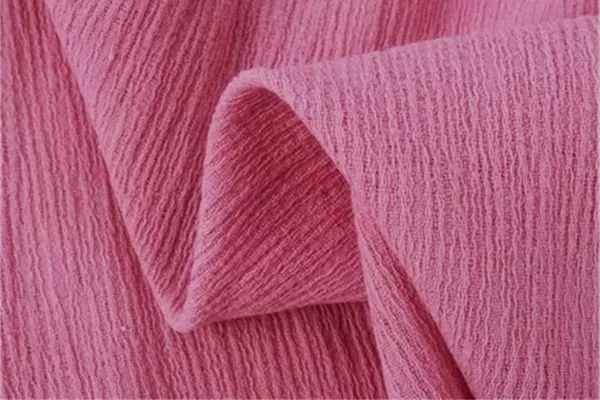
If you wonder what makes Crepe fabric apart, it is the yarn that is made by complex twisting. Also, yarns are woven alternatively between an S and Z twist, giving Crepe fabric a ‘ bounce.’
What is Crepe fabric made of?
Crepe fabric can be woven from Wool, Silk, and Polyester. These fabrics are mainly known for the subtle wrinkle-resistant texture that is created by twisted yarns. The common styles of Crepe fabric are semi-sheer georgette and heavy wool-suited material.
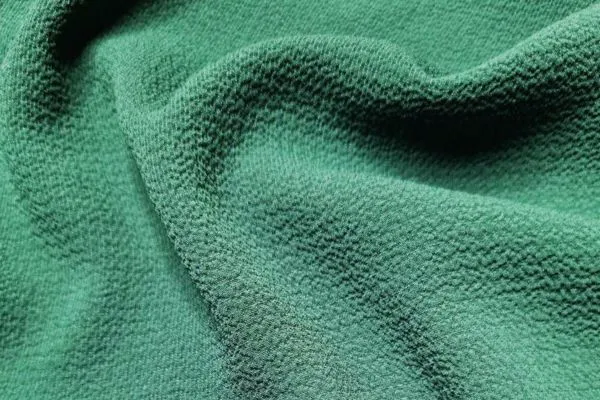
Modern crepe is also made of cotton. No matter which material is used, Crepe twists the fiber before it gets into the weaving process with signature textiles and a pebbled appearance.
10 Different Types of Crepe Fabric
Crepe fabric can be differentiated into ten different types. One type is distinct from another based on weaving technique, fiber, and finishes. The common types are:
- Crepe de Chine:
Crepe de Chine is a light fabric that is commonly made of silk. It is silky with a matte finish and slight texture.

- Crepe Georgette:
Crepe georgette fabric is smooth, velvety, and typically constructed of silk-like fibers like rayon. Silk georgette has some flexibility and drapes well. It is a popular material for dresses.

- Wool Crepe:
Wool crepe has a rough, wiry surface. It is constructed of wool, which is frequently combined with cotton or synthetic textiles.
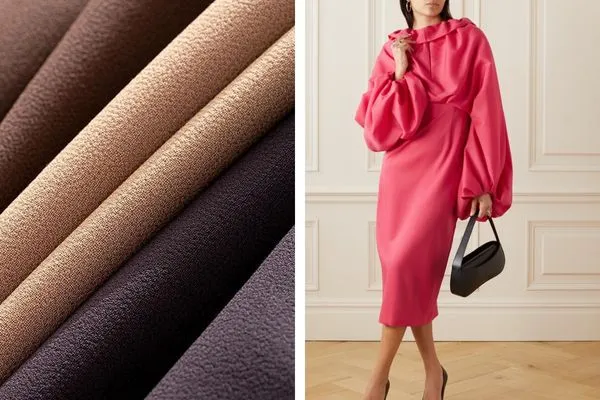
- Polyester Crepe:
Polyester crepe fabric is created from polyester, a synthetic fiber. It’s usually light and thin, with a beautiful drape.

- Rayon Crepe:
This crepe is made of rayon, which is a somewhat synthetic textile. It has a heavier weight than silk crepe and falls wonderfully.
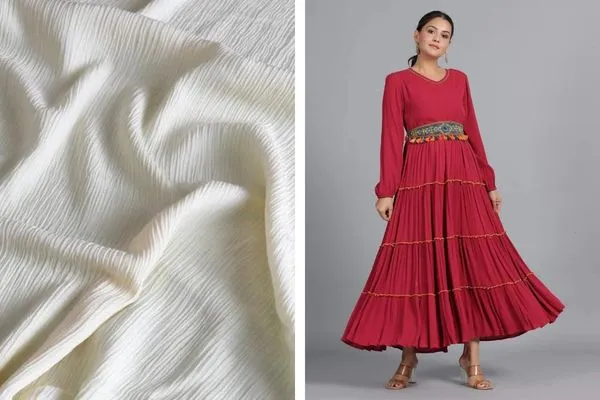
- Crepe Back Satin:
Crepe Back Satin has a shiny satin side and a textured crepe side, allowing designers to choose either.

- Crepe Chiffon:
Crepe Chiffon is a lightweight fabric with a sheer texture and a slight roughness.

- Japanese Crepe:
This is quite an unpopular crepe type with a heavy and highly textured surface.

- Moss Crepe:
Moss Crepe has a crimped appearance with a mossy texture. It is a polyester or rayon-made crepe type.
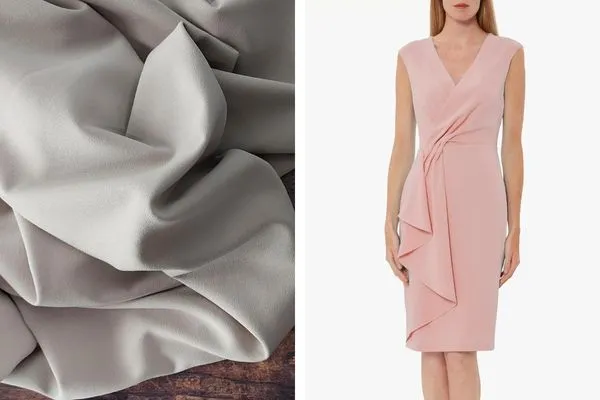
- Crepe Jersey:
A Crepe Jersey is a stretchy crepe type. It is a blend of fiber made of synthetic materials. Materials can be polyester or Spandex.
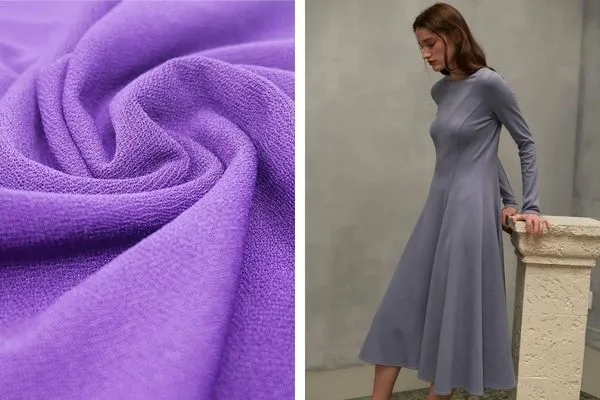
There are some other crepe fabric types. For instance, Moroccan crepe is woven, heavy, and has a ribbed design. Plisse crepe has unique look. Its pebbled and striped pattern distinguishes it.
Advantages of Crepe fabric
Crepe fabric has the following benefits:
- Breathable.
- It offers excellent ventilation in warm weather.
- Versatile.
- It can be used in many areas.
- Moisture-absorbent.
Disadvantage of Crepe fabric
Crepe fabric has the following
- When washed, it is prone to shrinking.
- Dry cleaning is a must.
- Silk crepe fabric is expensive.
- Low resistance to heat.
What is Crepe Fabric Used for?
Crepe fabric is used for many purposes. For instance:
Dressmaking: Occasional or Evening Wear, Cotton or Linen wrap dress.
Decorative Pieces: Throw Pillows, home design, curtains, table runners, slipcovers.
FAQs
Is Crepe a good quality fabric?
Generally, Crepe is well-considered as a high-quality fabric due to its beautiful drape. Its unique crinkled surface makes it suitable for both fashion and home decor.
However, quality may differ based on the material used and the fabric’s process. No matter what material is used, the elegant appearance of Crepe fabric serves better.
Is Crepe a stretchy fabric?
If Crepe is made from synthetic fibers, it might have a bit of stretch. Sometimes, the stretch measures up to 4 inches. But silk, wool, or cotton-made Crepe fabric may not have any stretch due to the material’s nature. Meanwhile, Spandex-like material gives the fabric stretchy properties.
Is Crepe fabric suitable for summer?
Crepe is an excellent choice for summer. It is all because of its lightweight and breathable properties. Also, it has an airy texture that allows for better airflow in warmer temperatures.
Since the fabric drapes beautifully, it will not feel tight to the wearer’s body. Which ultimately means comfortable wear in hot weather like summer.
Is Crepe fabric cotton or polyester?
Crepe fabric is not exclusively a cotton or polyester-made fiber. It can be cotton or polyester, depending on the manufacturer’s material.
Is Crepe fabric better than Cotton?
Whether Crepe fabric is better than cotton depends on the purpose of use. Polyester-made Crepe fabric might not be the better option compared to cotton. Meanwhile, cotton-made fabric could be the better choice for the intended purpose.
Is Crepe better than Chiffon?
As a fabric, Crepe is slightly heavier, more textured, and has better drape ability. Meanwhile, Chiffon is lightweight, sheer, and with a delicate appearance.
Both fabrics have unique qualities. So, ultimately, the choice is yours based on the purpose for which you will use any of them.
Is Crepe fabric thin or thick?
Crepe fabric has medium-weight coverage. Wool Crepe can be thicker compared to polyester crepe. It ultimately depends on the material used.
Does Crepe wrinkle easily?
Crepe fabric has resistance to wrinkles. It helps any clothing to maintain its appearance even after heavy use. But Crepe has a wrinkled or bumby similar look.
Which is better, Georgette or Crepe?
Crepe and Georgette are both different fabrics. Georgette is a silk-made matte, dull, thick, and shiny fabric. However, the crepe fabric can be vast and thin depending on the material used and has a less lustrous effect. Which one is better between them depends on the purpose of use.
Is Crepe fabric shiny?
Usually, Crepe fabric appears as a matte look. But silk crepe fabric can have a gentle shine.
Conclusion
At the end of the article, it is worth saying that Crepe fabric has specific advantages. For instance, it is well-known for its peculiar texture, good draping, and rich feel. It is made from various materials such as silk, wool, or synthetic fibers and is lightweight and drapable, making it excellent for specific clothing styles and exquisite designs.
Because of its smoothness and drape, crepe is more prone to wrinkling. Following laundry instructions and using low heat for steaming or ironing helps to minimize wrinkles and keep the beauty of the fabric.
